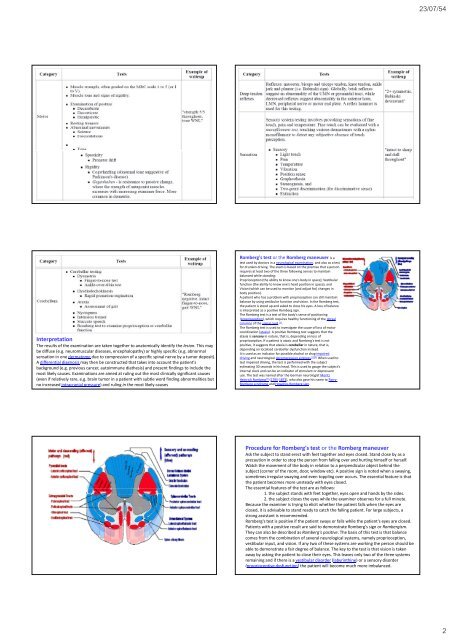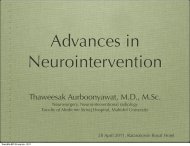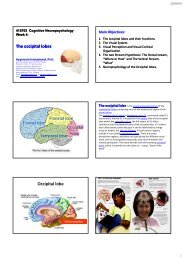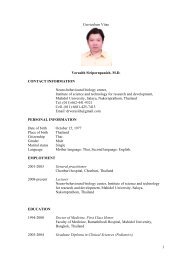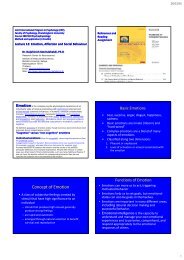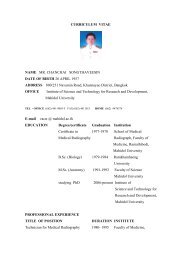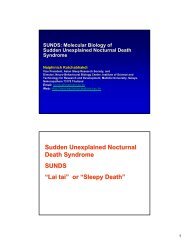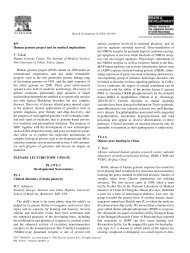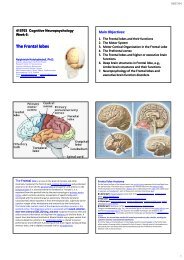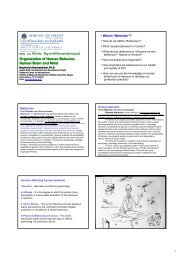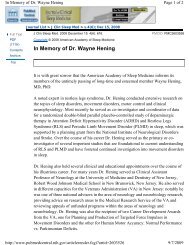Neurological Examination, clinical cases and neuropsychological ...
Neurological Examination, clinical cases and neuropsychological ...
Neurological Examination, clinical cases and neuropsychological ...
Create successful ePaper yourself
Turn your PDF publications into a flip-book with our unique Google optimized e-Paper software.
23/07/54<br />
Interpretation<br />
The results of the examination are taken together to anatomically identify the lesion. This may<br />
be diffuse (e.g. neuromuscular diseases, encephalopathy) or highly specific (e.g. abnormal<br />
sensation in one dermatome due to compression of a specific spinal nerve by a tumor deposit).<br />
A differential diagnosis may then be constructed that takes into account the patient's<br />
background (e.g. previous cancer, autoimmune diathesis) <strong>and</strong> present findings to include the<br />
most likely causes. <strong>Examination</strong>s are aimed at ruling out the most <strong>clinical</strong>ly significant causes<br />
(even if relatively rare, e.g. brain tumor in a patient with subtle word finding abnormalities but<br />
no increased intracranial pressure) <strong>and</strong> ruling in the most likely causes<br />
Romberg's test or the Romberg maneuver is a<br />
test used by doctors in a neurological examination, <strong>and</strong> also as a test<br />
for drunken driving. The exam is based on the premise that a person<br />
requires at least two of the three following senses to maintain<br />
balanced while st<strong>and</strong>ing:<br />
Proprioception (the ability to know one's body in space); Vestibular<br />
function (the ability to know one's head position in space); <strong>and</strong><br />
Vision (which can be used to monitor [<strong>and</strong> adjust for] changes in<br />
body position).<br />
A patient who has a problem with proprioception can still maintain<br />
balance by using vestibular function <strong>and</strong> vision. In the Romberg test,<br />
the patient is stood up <strong>and</strong> asked to close his eyes. A loss of balance<br />
is interpreted as a positive Romberg sign.<br />
The Romberg test is a test of the body's sense of positioning<br />
(proprioception), which requires healthy functioning of the dorsal<br />
columns of the spinal cord, [1] .<br />
The Romberg test is used to investigate the cause of loss of motor<br />
coordination (ataxia). A positive Romberg test suggests that the<br />
ataxia is sensory in nature, that is, depending on loss of<br />
proprioception. If a patient is ataxic <strong>and</strong> Romberg's test is not<br />
positive, it suggests that ataxia is cerebellar in nature, that is,<br />
depending on localized cerebellar dysfunction instead.<br />
It is used as an indicator for possible alcohol or drug impaired<br />
driving <strong>and</strong> neurological decompression sickness. [2][3] When used to<br />
test impaired driving, the test is performed with the subject<br />
estimating 30 seconds in his head. This is used to gauge the subject's<br />
internal clock <strong>and</strong> can be an indicator of stimulant or depressant<br />
use. The test was named after the German neurologist Moritz<br />
Heinrich Romberg [1] (1795‐1873), who also gave his name to Parry‐<br />
Romberg syndrome <strong>and</strong> Howship‐Romberg sign.<br />
Procedure for Romberg's test or the Romberg maneuver<br />
Ask the subject to st<strong>and</strong> erect with feet together <strong>and</strong> eyes closed. St<strong>and</strong> close by as a<br />
precaution in order to stop the person from falling over <strong>and</strong> hurting himself or herself.<br />
Watch the movement of the body in relation to a perpendicular object behind the<br />
subject (corner of the room, door, window etc). A positive sign is noted when a swaying,<br />
sometimes irregular swaying <strong>and</strong> even toppling over occurs. The essential feature is that<br />
the patient becomes more unsteady with eyes closed.<br />
The essential features of the test are as follows:<br />
1. the subject st<strong>and</strong>s with feet together, eyes open <strong>and</strong> h<strong>and</strong>s by the sides.<br />
2. the subject closes the eyes while the examiner observes for a full minute.<br />
Because the examiner is trying to elicit whether the patient falls when the eyes are<br />
closed, it is advisable to st<strong>and</strong> ready to catch the falling patient. For large subjects, a<br />
strong assistant is recommended.<br />
Romberg's test is positive if the patient sways or falls while the patient's eyes are closed.<br />
Patients with a positive result are said to demonstrate Romberg's sign or Rombergism.<br />
They can also be described as Romberg's positive. The basis of this test is that balance<br />
comes from the combination of several neurological systems, namely proprioception,<br />
vestibular input, <strong>and</strong> vision. If any two of these systems are working the person should be<br />
able to demonstrate a fair degree of balance. The key to the test is that vision is taken<br />
away by asking the patient to close their eyes. This leaves only two of the three systems<br />
remaining <strong>and</strong> if there is a vestibular disorder (labyrinthine) or a sensory disorder<br />
(proprioceptive dysfunction) the patient will become much more imbalanced.<br />
2


